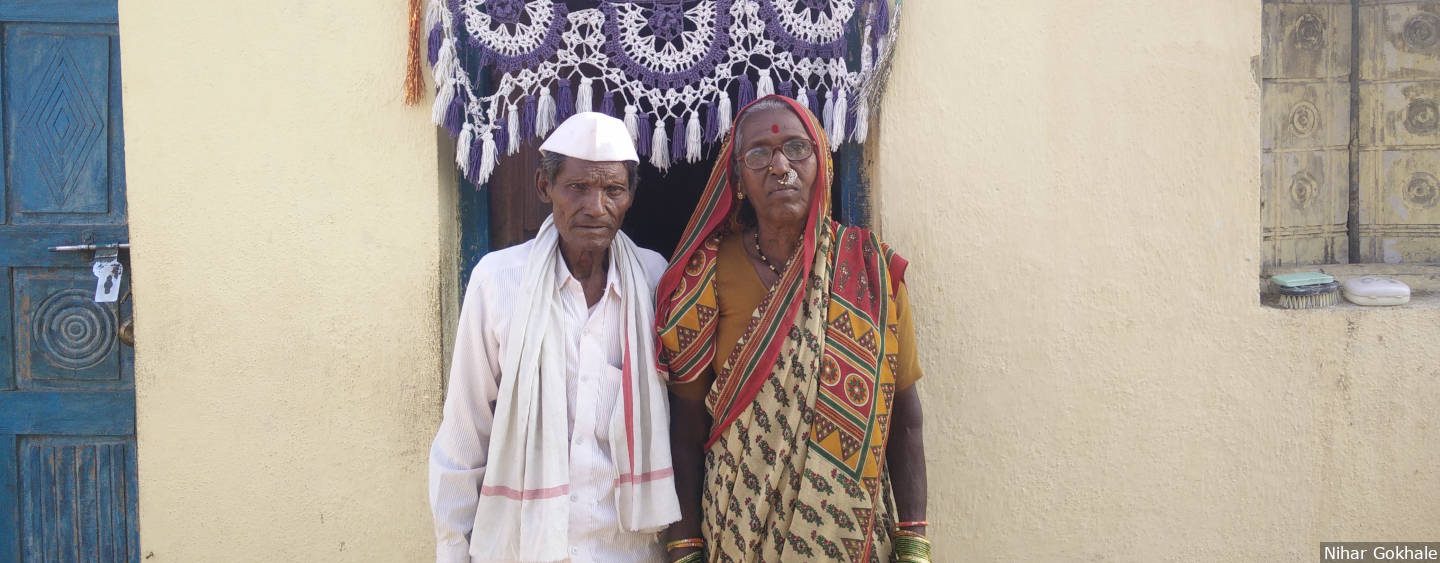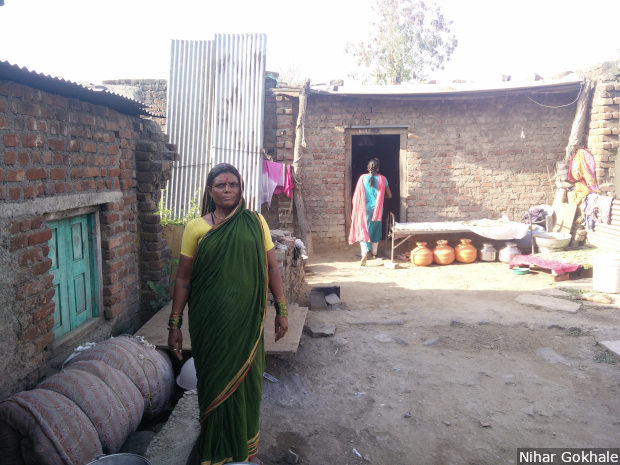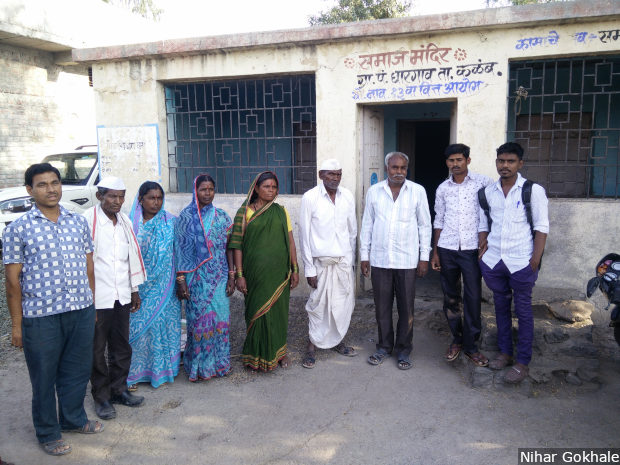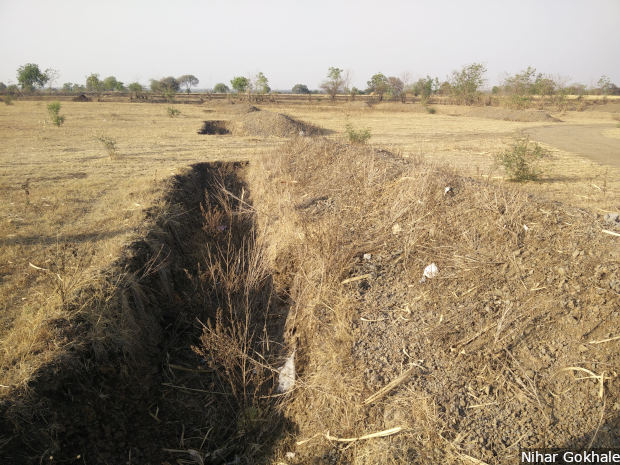Dalit Battles For Promised Lands Rage Across India

Osmanabad (Maharashtra): Rambhau Kamble was five years old when he first saw Bhimrao Ramji Ambedkar. On that February morning in 1941, Ambedkar--eight years away from framing India’s constitution but already the most prominent dalit leader of his times--addressed a public rally in Marathwada, now a part of the state of Maharashtra in western India.
“Every dalit from the region was there,” Kamble, now a frail 80-year-old, recalled at his one-room house in Gharegaon village in the southeastern Maharashtra district of Osmanabad.
Kamble is among the nearly 100,000 dalit farmers who heeded Ambedkar’s call and occupied grazing land, termed ‘gairan’, across Marathwada. At its peak in 1991, the movement occupied 100,000 hectares of land--the equivalent area of today’s Pune and Bengaluru put together.
In 2019, the movement is as real as it was in 1941 for Rambhau and 11,000 other dalit families in Marathwada, a region of 64,590 sq km, about half the geographical area of Tamil Nadu. They still occupy government land because seven decades of land reforms and government programmes aimed at providing land to dalits and other historically oppressed communities didn’t quite work.
Almost 60% dalit households did not own any farmland in 2013--the latest year for which figures are available--according to the India Land and Livestock Holding Survey. Nearly 70% of dalit farmers are labourers on farms owned by others, according to Census 2011.
Ambedkar, who belonged to a dalit community from western Maharashtra, argued that rural dalits should be given cultivable land controlled by the government and commons, such as grazing land. At the Marathwada rally in 1941, he urged dalits to capture public land in villages and cultivate it. By doing so, he said, they could become self-sufficient farmers.
Across 13 Indian states, there are 31 conflicts involving 92,000 dalits who are fighting to claim land, according to Land Conflict Watch, a network of researchers that maps and collects data on land conflicts in India. The wilful occupying of government land in Maharashtra has spread to Punjab, Kerala and Tamil Nadu. In Bihar, Gujarat and Madhya Pradesh, land titles given to dalits over the years in land-redistribution programmes are useless because higher castes, who originally owned the land, never ceded control.
After Independence in 1947, Indian states, which alone have the right to pass land legislation, introduced laws aimed at breaking down large landholdings of zamindars or feudal landlords, and distribute the surplus land so generated to the landless, including dalits.
However, the implementation of land reform laws has been poor because no government is willing to antagonise landowners, who are from dominant castes, said T Vincent Manoharan, chairperson of the National Federation of Dalit Land Rights Movement, an umbrella group of more than 100 grassroots movements.
Politicians blame bureaucrats for not implementing the laws properly, while bureaucrats allege interference from politicians, who are, often, large landowners themselves. “But when a mega project is proposed, they easily acquire land, no matter who it belongs to,” said Manoharan.
Once called untouchables, now officially ‘scheduled castes’, dalits were compelled to work in professions defined by the Hindu caste system. The jobs of dalits--a name derived from the Sanskrit word for oppression--included cleaning toilets, handling cattle carcasses, making leather, and farm labour. They were barred from entering temples, and drawing water from wells used by the people of higher castes. They were not allowed education or to own land. Many of these restrictions still stand.
The struggle in Marathwada
Kamble’s neighbour, Sunanda Kamble (no relation), is a 50-something cheerful woman in a green saree and a large vermilion mark on her forehead. She clearly remembered the day in 1989 when she and a few other women held sickles and walked to unproductive grazing land in the village.
They had heard on the radio that dalits were occupying gairan land. Sunanda’s relatives, who were visiting from the neighbouring district of Beed, told her that they had occupied some land and encouraged her to do the same.
On the gairan, Sunanda and other women dug furrows with sickles and planted jowar (sorghum) seeds. A few weeks later, the seeds sprouted. Eventually, the village’s dalits divided 22 hectares of the 32-hectare spread of gairan among themselves, depending on how much seed and labour each was able to afford. This was the third time that dalits in Gharegaon occupied gairan land.

Sunanda Kamble was among the dalit women who, in 1989, occupied the gairan (grazing) land in Gharegaon village in the southeastern Maharashtra district of Osmanabad. She had heard from her relatives from the neighbouring Beed district that the occupation movement was picking up again.
The occupation of public land in Marathwada has come in waves. The first one was in the 1940s, following Ambedkar’s call. Another took place in the ’60s and ’70s under Dadasaheb Gaikwad, a popular dalit leader and a close associate of Ambedkar. In 1978, the state government issued an order regularising all encroachments made until then.
The dalits kept occupying land, partly because they had frequently abandoned some due to the region’s notorious droughts and pressure from the local administration, often from higher castes.
Kamble’s family, for example, had first occupied the gairan in 1945 but a drought in the following year had forced the family to move to Mumbai to work as daily wage labourers. They came back and occupied the land again in the ’70s but had to give it up again after, as Rambhau put it, “pressure from the upper-caste landowners”.
In 1991, two years after Sunanda and others occupied land, the state government agreed to the dalit land rights movement’s demand to regularise occupied land. It issued an order stating that land titles would be given to those who could prove encroachment for at least one year before April 14, 1990, Ambedkar’s birth anniversary.
Between 1978 and 1991, 84,230 people occupied nearly 100,000 hectares of gairan across Maharashtra, according to an estimate in the government order.
But most farmers did not have proof that they were in possession of the land, said Ashruba Gaikwad, district convenor of the Jamin Adhikar Andolan (land rights agitation), a movement that has helped about 35,000 dalits with the paperwork required to file for land titles. In the absence of official evidence, the Andolan helped people like Sunanda Kamble obtain affidavits from village elders, grazers and helpful farmers, certifying they had occupied the land.
The government, however, insisted on using only official records, such as encroachment notices from revenue officers or police complaints, Gaikwad said. Not all occupiers had been penalised, and in many cases farmers had not saved the paperwork, so they missed their opportunity.
Another reason for the recurring land-occupation drives in Maharashtra is the state’s failure to implement its land reform law--the Maharashtra Agricultural Lands (Ceiling on Holdings) Act, 1961. The law set an upper limit to the size of land one could possess. Any land above the limit would be taken over by the state and distributed, first to tenant farmers cultivating the land and then to landless dalits and adivasis (tribals).
But by March 2001, just 2% of the farmed area in Maharashtra had been declared surplus--among the lowest nationwide--according to a 2007 Planning Commission report. Landlords in Maharashtra avoided having their landholdings declared surplus by using false documents, partitioning land among family members, understating the extent of land owned and showing underage sons as adults, according to a 2005 study by the government-run Lal Bahadur Shastri National Academy of Administration.
As a result, Maharashtra had distributed land to just 41,039 dalit households, according to 2008 ministry of rural development data, the latest available. That benefitted 5% of 854,000 landless dalit households in the state as per the 2011 socio-economic and caste census.
Dalit farmers such as Kamble, who neither received surplus land nor could get occupied land regularised, are not eligible for bank loans, crop insurance, electricity connections for irrigation pumps or drought relief.
On learning that the Nizam of Hyderabad, who ruled Marathwada then, had in 1948 probably issued a decree regularising all encroachments on grazing land, a few dalit farmers from Gharegaon one day in 2017 went to the block administration office, bribed the peon to dig out Nizam-era records, written in Urdu, and spent a whole day poring over the dusty files. But they could not locate any files on the encroachments.
Over the decade to 2019, dalit farmers have held a number of protests in the state capital, Mumbai, and the national capital, New Delhi. They have submitted letters to the chief minister and district collectors, detailing the area they occupied and the crops under cultivation, and attached photographs of themselves standing in front of their harvests. In the letters, they have asked for title in the name of both husband and wife, and requested irrigation facilities. One 2018 letter makes the plea: “Please help increase the national food output by securing the livelihood of gairan encroachers.”
In desperation, some of those who have occupied gairan have begun to petition the administration to urge action against themselves, so that it creates the official evidence they never had. A representation made by Gharegaon’s dalit families asks the block office to send inspectors to the land, prepare a panchnama, or official record, of evidence of crops under cultivation and impose penalties on them.
“Can you imagine a person pleading the government to prosecute him?” asked Arvind Kamble, one of the encroachers. “This is our situation now.”
Across states, similar challenge--and a few solutions
As many as 81% of dalit farmers in Maharashtra were agricultural labourers, who had no land of their own and worked on others’ farms land as opposed to 49% of landless farmers among non-dalits, according to Census 2011. In at least three other states with a larger proportion of landlessness, dalits have similarly occupied government land.
In 2014, the dalits of Punjab’s Sangrur district--where 90% of dalit farmers are agricultural workers--occupied 6,475 hectares of vacant land and asked the government to give them titles. In Punjab, dalits constitute a third of the population, the highest in India. They have accused the state of not implementing laws that reserve public land for dalits for farming and building homes. The protesters, organised under the Zamin Prapti Sangharsh Samiti or ‘movement to obtain land’, have threatened to intensify their occupation drives, if land is not lawfully granted to them.
In Kerala, where 93% of dalit farmers are farm labourers, dalits and adivasis occupied parts of a 25,000-hectare rubber plantation in Chengara in the southern district of Pathanamthitta in 2007. They point to two flaws in the state’s 1963 land reforms, which are otherwise considered a success. The reforms only covered “intermediaries”, such as tenants, who were typically upper caste, and not farm labourers, who were dalits or adivasis. The reforms also exempted plantations from giving up excess land. That meant large estates, like the one at Chengara, could not be distributed to the landless.
In 2012, more than 22 hectares of government land in Arippa in Kollam district of Kerala were occupied by dalit families, who discovered that the land, which was earmarked to be distributed to them, was being instead allotted to a dental college and a university campus.
In 2017, landless dalit women in Tamil Nadu’s Vellore district--where 87% of dalit farmers are landless--occupied a one-hectare patch of government-owned common land and began cultivating it with food crops.
Landless dalits in Gujarat and Bihar--states on opposite economic ends but where over 80% of dalit farmers work on others’ farms--face another problem: they were given titles under land reforms, but their land is in possession of higher castes.
Only half the dalit households in six Gujarat districts were found to have been in possession of the land they had been allotted, according to a 2015 survey. More than half of these households had to fight for at least five years to gain possession of the land. Long before dalit leader Jignesh Mewani shot to prominence after an incident in Una town, where seven dalit men were beaten for skinning a dead cow, he fought court cases to help dalits take possession of the land granted to them.
In 2014, Bihar--where almost 90% of dalit farmers are farm labourers--became the first state to recognise that lack of possession was a problem that needed state intervention. At the time, about 500,000 of the state’s 2.3 million dalits were yet to take possession of the land granted to them.
Jitan Ram Manjhi, the then chief minister of Bihar and the first dalit to hold the post, launched ‘Operation Dakhal Dehani’ or ‘giving possession’, under which camps were set up in villages and police and revenue officers helped dalits gain control of the land they had received titles to decades earlier. In 2018, when the operation ended, only about 40,000 families--or 25% of those eligible--were still without land and that was because of litigation, according to a Bihar government website.
The government plays a critical role in giving land to dalits because even if they can afford to buy land, they are discriminated against by sellers, said Sukhdeo Thorat, an economist and expert on caste discrimination. An unpublished field study by Thorat’s team, covering Tamil Nadu, Haryana, Maharashtra and Uttar Pradesh, found that dalits typically pay higher prices for land and are usually not sold “high-quality land”--near irrigation canals or next to fields of dominant-caste farmers. “The government has to give the ownership of public lands to the scheduled castes,” said Thorat.
An alternative to providing public land could be a programme like the one Telangana introduced in 2014. Under the Land Purchase Scheme, the Telangana government bypasses the difficulties of redistributing land to dalits by buying land from landowners and giving about three acres (1.2 hectares) to each landless dalit family. The state has so far purchased 6,070 hectares of land and distributed it to about 6,000 dalit families.
Under the Telangana programme, the families also receive irrigation and funds for fertiliser, pesticides and other things required for farming. However, dalit groups and human rights activists have criticised the scheme for slow progress, and some families have complained of poor quality land.
Return to landlessness
In Marathwada, the odds are stacking up against the dalits fighting to get the land they occupied regularised. In 2011, the Supreme Court ordered all state governments to ensure that encroachments on commons by individuals or by institutions were not regularised.
“Our ancestors were not fools,” the judgement by Justice Markandey Katju observed, referring to the ecological reasons--such as water harvesting--that led to the creation of commons in every village. Within weeks, the Maharashtra government issued a resolution stating that it would no longer regularise ‘encroachments’ on grazing land.
In 2016, the Maharashtra government launched an afforestation project by planting trees to bring one-third of the state’s area under tree cover. The plan calls for 500 million trees on government land statewide by 2020. Those trees are being planted on gairan in Marathwada.
In April 2017, as Sunanda Kamble and others reached the fields to harvest pigeon pea, they noticed that an earth mover had begun to dig trenches, one-metre wide and five-metre, long on their farms--to plant saplings. The farmers said they stood in front of the earth mover and threatened to throw stones and set the machine on fire if the operator did not stop.
“The women used such curse words that the operator, whom I know, told me he lost his appetite for several days,” one of the villagers said.
The dalits then took a bus to Osmanabad town and filed a complaint with the district collector. They did not hear back from the administration, but the earth movers did not return. When the villagers accessed land records, they found that in 2015 the district administration had transferred all the grazing land to the forest department, without any public notice or informing them.

Dalit families gather near a community centre in Gharegaon in Maharashtra’s Osmanabad district. Dalits own no land in the village and work as labourers on the farms of upper-caste farmers. During the region’s recurring droughts, they migrate to western Maharashtra or to Mumbai in search of work.
A district forest officer, who did not wish to be named, said that although nearly 5,000 hectares of gairan had been transferred to the forest department, they had taken possession of only 900 hectares because the remaining land was occupied by dalit farmers.
“Our department is asking the collector to help us... maybe to give some alternative land to the occupants,” said the forest officer.
But a senior district officer said, also on condition of anonymity, that there was “no way” the collector could grant titles to the occupants or relocate them. “The land now belongs to forest department and it is all up to them now,” he said.
Granting gairan land to the Dalits was a “minimalist” demand considering that it is the least fertile land in villages, said Awanish Kumar, a Mumbai-based researcher who has recently completed a doctoral thesis on the gairan movement. “The land was abandoned by the villagers for being the least fertile, otherwise it would have been taken over by the dominant castes long ago.” The gairan movement is a struggle “to demand cultivation rights on land that is not even cultivable”, he said.
The dalits of Gharegaon abandoned their farms in 2017 after the forest department dug trenches. Rambhau Kamble said the farmers could not afford the risk of having their crop razed by the department. It costs about Rs 10,000 to cultivate an acre (0.4 hectare), and the farmers turn to moneylenders and savings from meagre farm-labour wages.

In 2017, Maharashtra’s forest department began digging pits in gairan (grazing) land to plant trees as a part of the government’s project to plant 500 million trees across the state.
As the 2019 monsoon approached, Kamble and the others wondered whether or not to sow, after a two-year gap. If they did not, the only jobs near the village were daily wage labour on large farms of higher castes. They wanted to hold on to the land, though they realise it is getting increasingly untenable.
“We want to cultivate this year, and it is quite likely that they [the government] will take action against us,” said Kamble. “But it is our right to have land of our own, so we won’t give up easily.”
(Gokhale is a writer with Land Conflict Watch, a network of researchers that collects data about ongoing land conflicts in India.)
![We The People ! [ Daily News ]](https://blogger.googleusercontent.com/img/b/R29vZ2xl/AVvXsEi7PNflLYO2id_pgKevcLALLVghNAUKitpe3VQpV5fJatRfWJCD5mtlJzat6fUgV7ymgMyAe1yNdVgoDeLbqc_5gXJpSzYE50pYDire_RBxd0JWLL96a-4NaYWD4QJ3EAFuXN6gNo1L5gs/s1600/LogoMakr_5zKJMi.png)











No comments:
Post a Comment